Research Proposal on Training and Employee Motivation at Harrods
VerifiedAdded on 2023/06/15
|14
|3823
|461
Project
AI Summary
This research proposal investigates the impact of training and development activities on employee motivation, focusing on a case study of Harrods. It begins with an introduction to training and development, defining its role in enhancing employee skills and organizational performance, and contrasts it with employee motivation techniques. The proposal outlines the aim to analyze this impact at Harrods, with objectives including exploring existing training programs, understanding employee motivation concepts, and recommending improvements. The literature review summarizes diverse perspectives on the benefits and limitations of training and motivation, emphasizing their interconnectedness. The theoretical perspective adopts epistemological and ontological approaches to underpin the research. The methodology section details the research philosophy (interpretivism), approach (inductive), and strategy, setting the stage for a comprehensive analysis of how training and development influence employee motivation within the specific context of Harrods.

S1 Research proposal
Paraphrase This Document
Need a fresh take? Get an instant paraphrase of this document with our AI Paraphraser
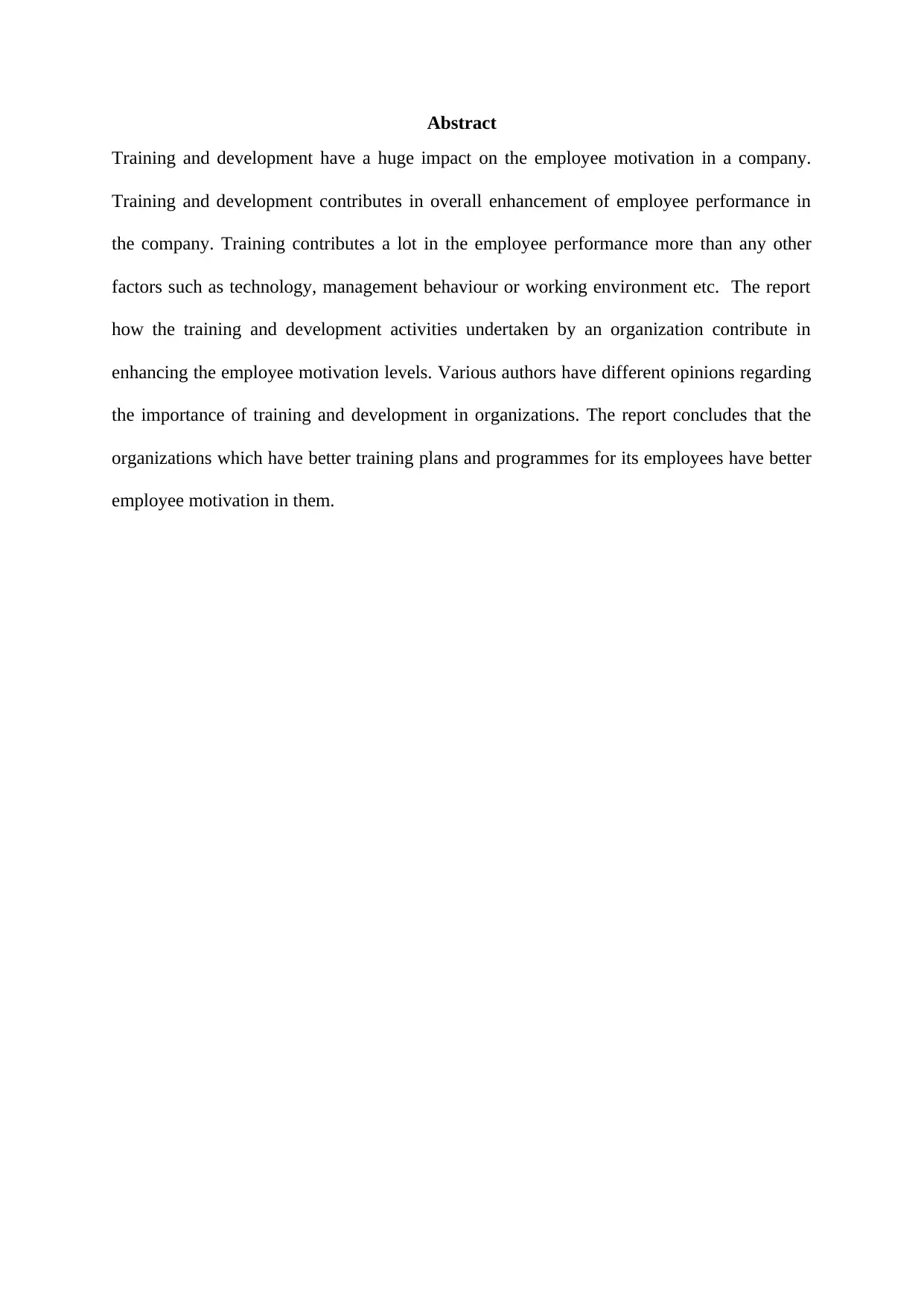
Abstract
Training and development have a huge impact on the employee motivation in a company.
Training and development contributes in overall enhancement of employee performance in
the company. Training contributes a lot in the employee performance more than any other
factors such as technology, management behaviour or working environment etc. The report
how the training and development activities undertaken by an organization contribute in
enhancing the employee motivation levels. Various authors have different opinions regarding
the importance of training and development in organizations. The report concludes that the
organizations which have better training plans and programmes for its employees have better
employee motivation in them.
Training and development have a huge impact on the employee motivation in a company.
Training and development contributes in overall enhancement of employee performance in
the company. Training contributes a lot in the employee performance more than any other
factors such as technology, management behaviour or working environment etc. The report
how the training and development activities undertaken by an organization contribute in
enhancing the employee motivation levels. Various authors have different opinions regarding
the importance of training and development in organizations. The report concludes that the
organizations which have better training plans and programmes for its employees have better
employee motivation in them.
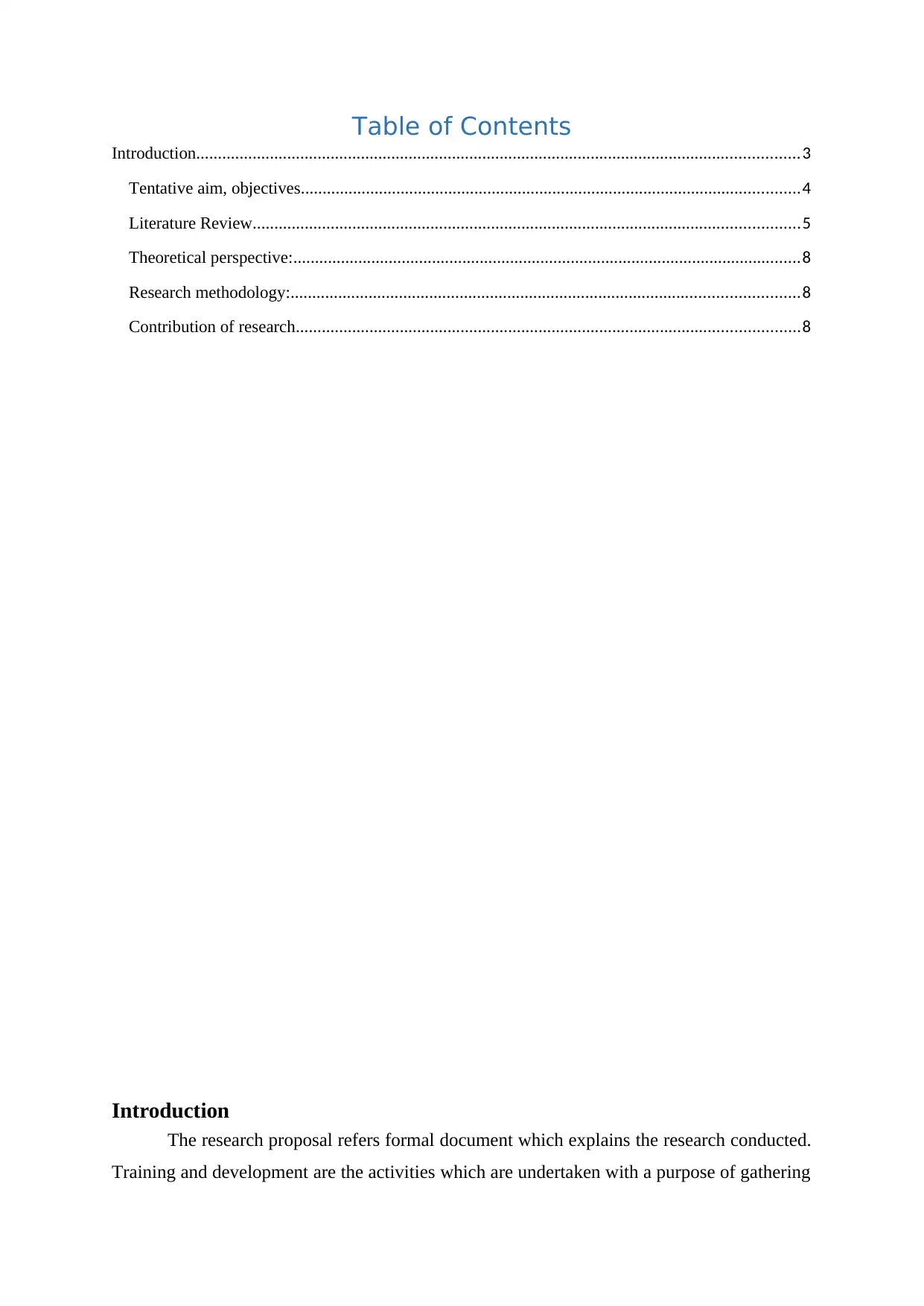
Table of Contents
Introduction...........................................................................................................................................3
Tentative aim, objectives...................................................................................................................4
Literature Review..............................................................................................................................5
Theoretical perspective:.....................................................................................................................8
Research methodology:.....................................................................................................................8
Contribution of research....................................................................................................................8
Introduction
The research proposal refers formal document which explains the research conducted.
Training and development are the activities which are undertaken with a purpose of gathering
Introduction...........................................................................................................................................3
Tentative aim, objectives...................................................................................................................4
Literature Review..............................................................................................................................5
Theoretical perspective:.....................................................................................................................8
Research methodology:.....................................................................................................................8
Contribution of research....................................................................................................................8
Introduction
The research proposal refers formal document which explains the research conducted.
Training and development are the activities which are undertaken with a purpose of gathering
⊘ This is a preview!⊘
Do you want full access?
Subscribe today to unlock all pages.

Trusted by 1+ million students worldwide
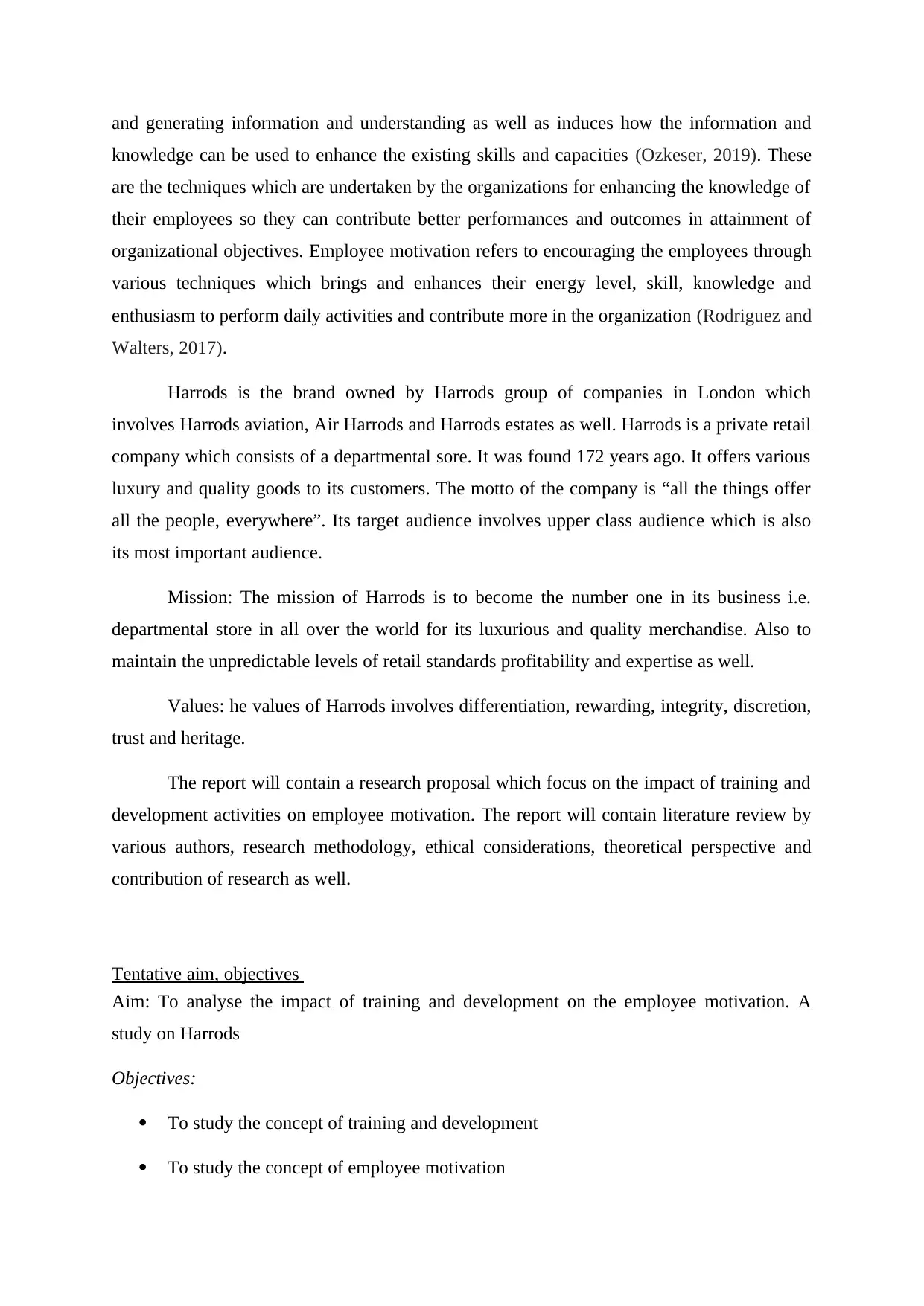
and generating information and understanding as well as induces how the information and
knowledge can be used to enhance the existing skills and capacities (Ozkeser, 2019). These
are the techniques which are undertaken by the organizations for enhancing the knowledge of
their employees so they can contribute better performances and outcomes in attainment of
organizational objectives. Employee motivation refers to encouraging the employees through
various techniques which brings and enhances their energy level, skill, knowledge and
enthusiasm to perform daily activities and contribute more in the organization (Rodriguez and
Walters, 2017).
Harrods is the brand owned by Harrods group of companies in London which
involves Harrods aviation, Air Harrods and Harrods estates as well. Harrods is a private retail
company which consists of a departmental sore. It was found 172 years ago. It offers various
luxury and quality goods to its customers. The motto of the company is “all the things offer
all the people, everywhere”. Its target audience involves upper class audience which is also
its most important audience.
Mission: The mission of Harrods is to become the number one in its business i.e.
departmental store in all over the world for its luxurious and quality merchandise. Also to
maintain the unpredictable levels of retail standards profitability and expertise as well.
Values: he values of Harrods involves differentiation, rewarding, integrity, discretion,
trust and heritage.
The report will contain a research proposal which focus on the impact of training and
development activities on employee motivation. The report will contain literature review by
various authors, research methodology, ethical considerations, theoretical perspective and
contribution of research as well.
Tentative aim, objectives
Aim: To analyse the impact of training and development on the employee motivation. A
study on Harrods
Objectives:
To study the concept of training and development
To study the concept of employee motivation
knowledge can be used to enhance the existing skills and capacities (Ozkeser, 2019). These
are the techniques which are undertaken by the organizations for enhancing the knowledge of
their employees so they can contribute better performances and outcomes in attainment of
organizational objectives. Employee motivation refers to encouraging the employees through
various techniques which brings and enhances their energy level, skill, knowledge and
enthusiasm to perform daily activities and contribute more in the organization (Rodriguez and
Walters, 2017).
Harrods is the brand owned by Harrods group of companies in London which
involves Harrods aviation, Air Harrods and Harrods estates as well. Harrods is a private retail
company which consists of a departmental sore. It was found 172 years ago. It offers various
luxury and quality goods to its customers. The motto of the company is “all the things offer
all the people, everywhere”. Its target audience involves upper class audience which is also
its most important audience.
Mission: The mission of Harrods is to become the number one in its business i.e.
departmental store in all over the world for its luxurious and quality merchandise. Also to
maintain the unpredictable levels of retail standards profitability and expertise as well.
Values: he values of Harrods involves differentiation, rewarding, integrity, discretion,
trust and heritage.
The report will contain a research proposal which focus on the impact of training and
development activities on employee motivation. The report will contain literature review by
various authors, research methodology, ethical considerations, theoretical perspective and
contribution of research as well.
Tentative aim, objectives
Aim: To analyse the impact of training and development on the employee motivation. A
study on Harrods
Objectives:
To study the concept of training and development
To study the concept of employee motivation
Paraphrase This Document
Need a fresh take? Get an instant paraphrase of this document with our AI Paraphraser
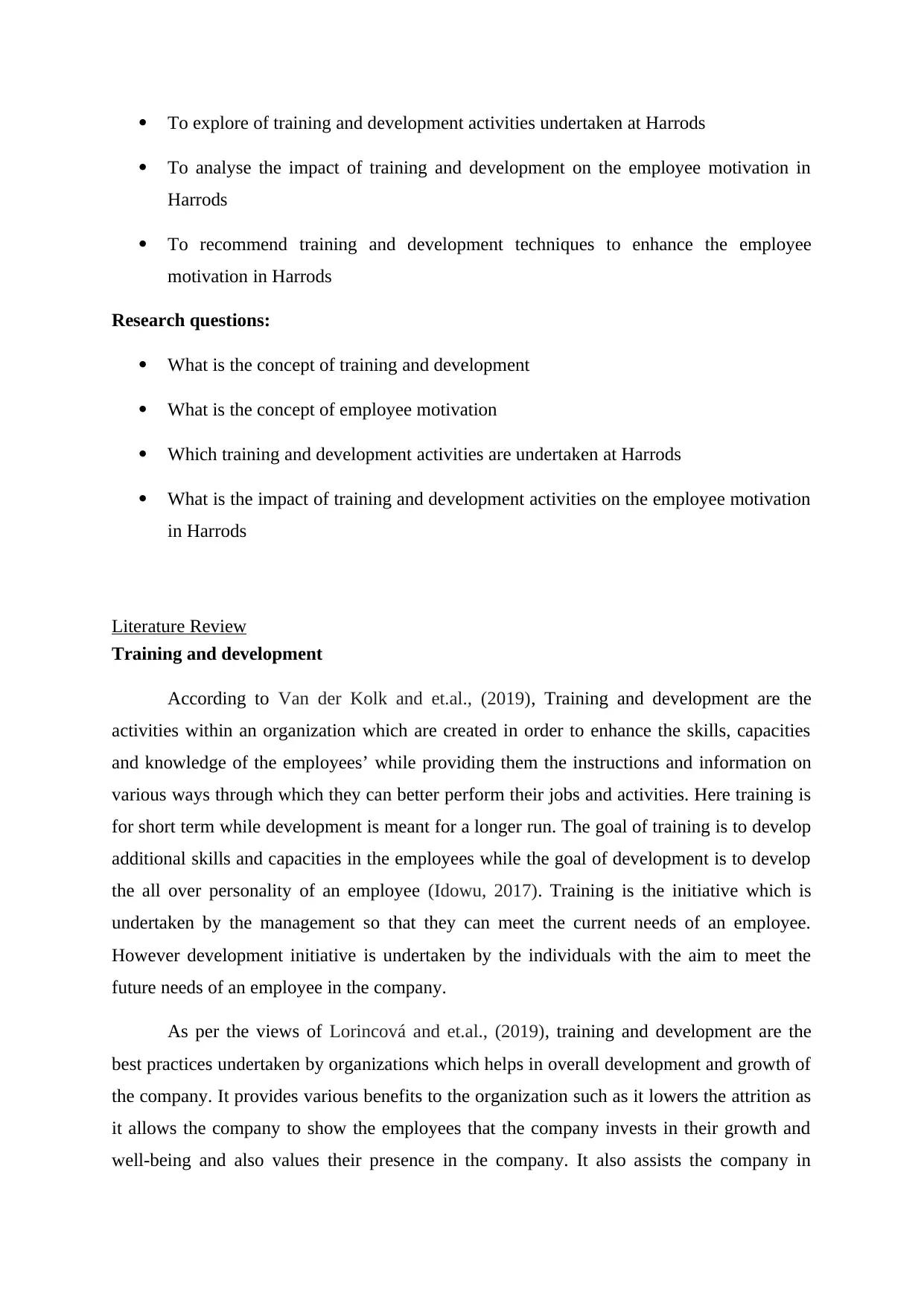
To explore of training and development activities undertaken at Harrods
To analyse the impact of training and development on the employee motivation in
Harrods
To recommend training and development techniques to enhance the employee
motivation in Harrods
Research questions:
What is the concept of training and development
What is the concept of employee motivation
Which training and development activities are undertaken at Harrods
What is the impact of training and development activities on the employee motivation
in Harrods
Literature Review
Training and development
According to Van der Kolk and et.al., (2019), Training and development are the
activities within an organization which are created in order to enhance the skills, capacities
and knowledge of the employees’ while providing them the instructions and information on
various ways through which they can better perform their jobs and activities. Here training is
for short term while development is meant for a longer run. The goal of training is to develop
additional skills and capacities in the employees while the goal of development is to develop
the all over personality of an employee (Idowu, 2017). Training is the initiative which is
undertaken by the management so that they can meet the current needs of an employee.
However development initiative is undertaken by the individuals with the aim to meet the
future needs of an employee in the company.
As per the views of Lorincová and et.al., (2019), training and development are the
best practices undertaken by organizations which helps in overall development and growth of
the company. It provides various benefits to the organization such as it lowers the attrition as
it allows the company to show the employees that the company invests in their growth and
well-being and also values their presence in the company. It also assists the company in
To analyse the impact of training and development on the employee motivation in
Harrods
To recommend training and development techniques to enhance the employee
motivation in Harrods
Research questions:
What is the concept of training and development
What is the concept of employee motivation
Which training and development activities are undertaken at Harrods
What is the impact of training and development activities on the employee motivation
in Harrods
Literature Review
Training and development
According to Van der Kolk and et.al., (2019), Training and development are the
activities within an organization which are created in order to enhance the skills, capacities
and knowledge of the employees’ while providing them the instructions and information on
various ways through which they can better perform their jobs and activities. Here training is
for short term while development is meant for a longer run. The goal of training is to develop
additional skills and capacities in the employees while the goal of development is to develop
the all over personality of an employee (Idowu, 2017). Training is the initiative which is
undertaken by the management so that they can meet the current needs of an employee.
However development initiative is undertaken by the individuals with the aim to meet the
future needs of an employee in the company.
As per the views of Lorincová and et.al., (2019), training and development are the
best practices undertaken by organizations which helps in overall development and growth of
the company. It provides various benefits to the organization such as it lowers the attrition as
it allows the company to show the employees that the company invests in their growth and
well-being and also values their presence in the company. It also assists the company in
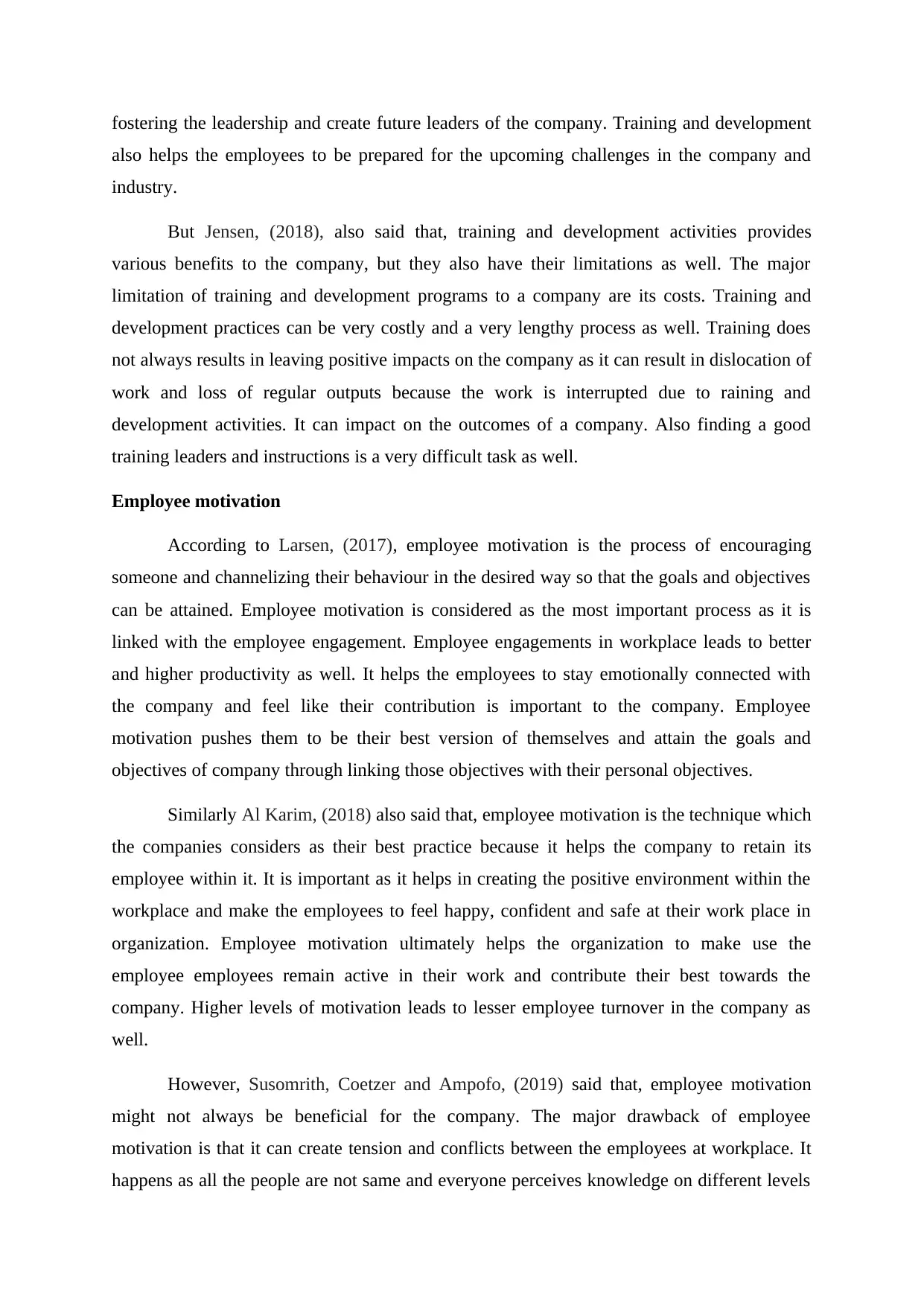
fostering the leadership and create future leaders of the company. Training and development
also helps the employees to be prepared for the upcoming challenges in the company and
industry.
But Jensen, (2018), also said that, training and development activities provides
various benefits to the company, but they also have their limitations as well. The major
limitation of training and development programs to a company are its costs. Training and
development practices can be very costly and a very lengthy process as well. Training does
not always results in leaving positive impacts on the company as it can result in dislocation of
work and loss of regular outputs because the work is interrupted due to raining and
development activities. It can impact on the outcomes of a company. Also finding a good
training leaders and instructions is a very difficult task as well.
Employee motivation
According to Larsen, (2017), employee motivation is the process of encouraging
someone and channelizing their behaviour in the desired way so that the goals and objectives
can be attained. Employee motivation is considered as the most important process as it is
linked with the employee engagement. Employee engagements in workplace leads to better
and higher productivity as well. It helps the employees to stay emotionally connected with
the company and feel like their contribution is important to the company. Employee
motivation pushes them to be their best version of themselves and attain the goals and
objectives of company through linking those objectives with their personal objectives.
Similarly Al Karim, (2018) also said that, employee motivation is the technique which
the companies considers as their best practice because it helps the company to retain its
employee within it. It is important as it helps in creating the positive environment within the
workplace and make the employees to feel happy, confident and safe at their work place in
organization. Employee motivation ultimately helps the organization to make use the
employee employees remain active in their work and contribute their best towards the
company. Higher levels of motivation leads to lesser employee turnover in the company as
well.
However, Susomrith, Coetzer and Ampofo, (2019) said that, employee motivation
might not always be beneficial for the company. The major drawback of employee
motivation is that it can create tension and conflicts between the employees at workplace. It
happens as all the people are not same and everyone perceives knowledge on different levels
also helps the employees to be prepared for the upcoming challenges in the company and
industry.
But Jensen, (2018), also said that, training and development activities provides
various benefits to the company, but they also have their limitations as well. The major
limitation of training and development programs to a company are its costs. Training and
development practices can be very costly and a very lengthy process as well. Training does
not always results in leaving positive impacts on the company as it can result in dislocation of
work and loss of regular outputs because the work is interrupted due to raining and
development activities. It can impact on the outcomes of a company. Also finding a good
training leaders and instructions is a very difficult task as well.
Employee motivation
According to Larsen, (2017), employee motivation is the process of encouraging
someone and channelizing their behaviour in the desired way so that the goals and objectives
can be attained. Employee motivation is considered as the most important process as it is
linked with the employee engagement. Employee engagements in workplace leads to better
and higher productivity as well. It helps the employees to stay emotionally connected with
the company and feel like their contribution is important to the company. Employee
motivation pushes them to be their best version of themselves and attain the goals and
objectives of company through linking those objectives with their personal objectives.
Similarly Al Karim, (2018) also said that, employee motivation is the technique which
the companies considers as their best practice because it helps the company to retain its
employee within it. It is important as it helps in creating the positive environment within the
workplace and make the employees to feel happy, confident and safe at their work place in
organization. Employee motivation ultimately helps the organization to make use the
employee employees remain active in their work and contribute their best towards the
company. Higher levels of motivation leads to lesser employee turnover in the company as
well.
However, Susomrith, Coetzer and Ampofo, (2019) said that, employee motivation
might not always be beneficial for the company. The major drawback of employee
motivation is that it can create tension and conflicts between the employees at workplace. It
happens as all the people are not same and everyone perceives knowledge on different levels
⊘ This is a preview!⊘
Do you want full access?
Subscribe today to unlock all pages.

Trusted by 1+ million students worldwide
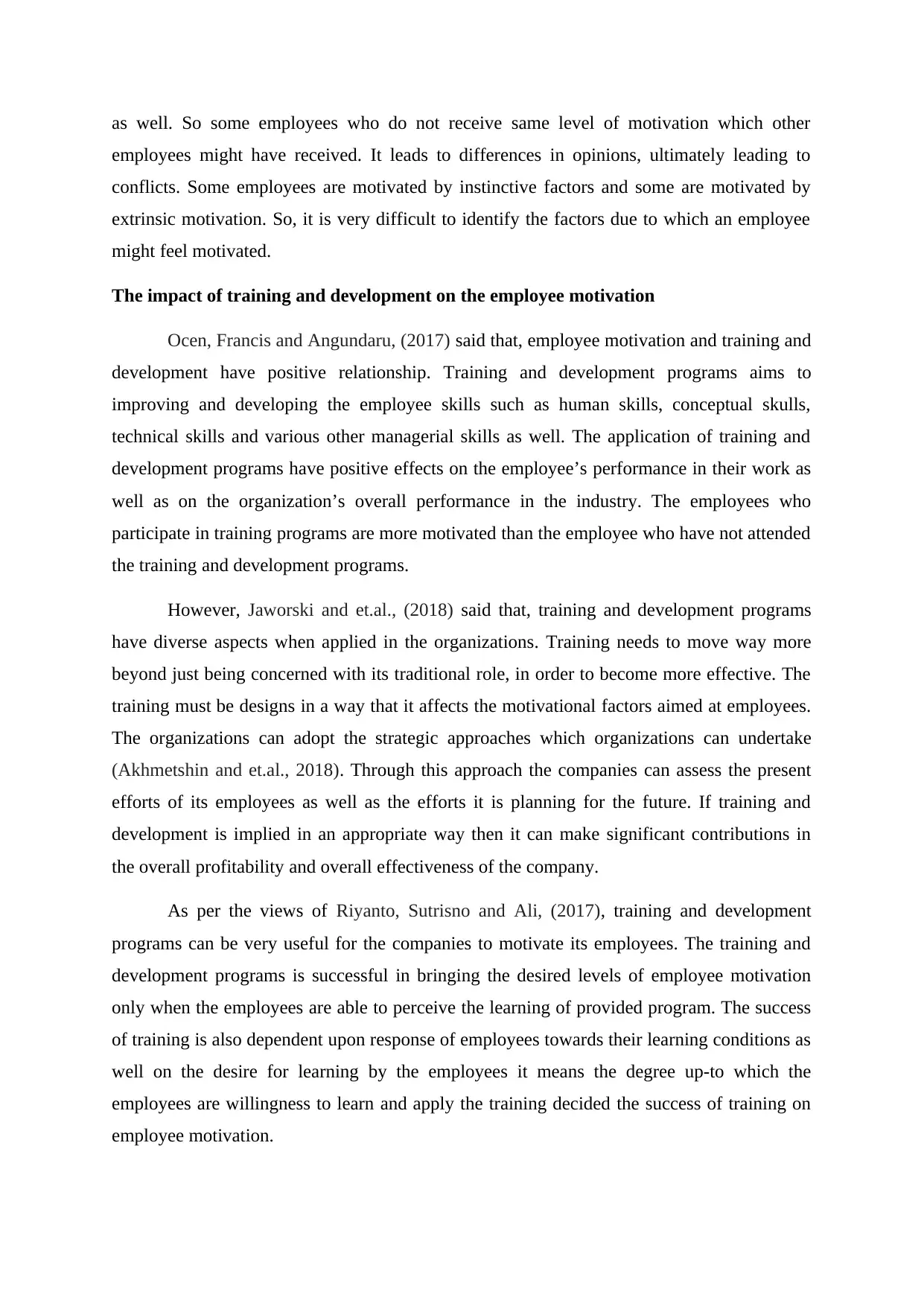
as well. So some employees who do not receive same level of motivation which other
employees might have received. It leads to differences in opinions, ultimately leading to
conflicts. Some employees are motivated by instinctive factors and some are motivated by
extrinsic motivation. So, it is very difficult to identify the factors due to which an employee
might feel motivated.
The impact of training and development on the employee motivation
Ocen, Francis and Angundaru, (2017) said that, employee motivation and training and
development have positive relationship. Training and development programs aims to
improving and developing the employee skills such as human skills, conceptual skulls,
technical skills and various other managerial skills as well. The application of training and
development programs have positive effects on the employee’s performance in their work as
well as on the organization’s overall performance in the industry. The employees who
participate in training programs are more motivated than the employee who have not attended
the training and development programs.
However, Jaworski and et.al., (2018) said that, training and development programs
have diverse aspects when applied in the organizations. Training needs to move way more
beyond just being concerned with its traditional role, in order to become more effective. The
training must be designs in a way that it affects the motivational factors aimed at employees.
The organizations can adopt the strategic approaches which organizations can undertake
(Akhmetshin and et.al., 2018). Through this approach the companies can assess the present
efforts of its employees as well as the efforts it is planning for the future. If training and
development is implied in an appropriate way then it can make significant contributions in
the overall profitability and overall effectiveness of the company.
As per the views of Riyanto, Sutrisno and Ali, (2017), training and development
programs can be very useful for the companies to motivate its employees. The training and
development programs is successful in bringing the desired levels of employee motivation
only when the employees are able to perceive the learning of provided program. The success
of training is also dependent upon response of employees towards their learning conditions as
well on the desire for learning by the employees it means the degree up-to which the
employees are willingness to learn and apply the training decided the success of training on
employee motivation.
employees might have received. It leads to differences in opinions, ultimately leading to
conflicts. Some employees are motivated by instinctive factors and some are motivated by
extrinsic motivation. So, it is very difficult to identify the factors due to which an employee
might feel motivated.
The impact of training and development on the employee motivation
Ocen, Francis and Angundaru, (2017) said that, employee motivation and training and
development have positive relationship. Training and development programs aims to
improving and developing the employee skills such as human skills, conceptual skulls,
technical skills and various other managerial skills as well. The application of training and
development programs have positive effects on the employee’s performance in their work as
well as on the organization’s overall performance in the industry. The employees who
participate in training programs are more motivated than the employee who have not attended
the training and development programs.
However, Jaworski and et.al., (2018) said that, training and development programs
have diverse aspects when applied in the organizations. Training needs to move way more
beyond just being concerned with its traditional role, in order to become more effective. The
training must be designs in a way that it affects the motivational factors aimed at employees.
The organizations can adopt the strategic approaches which organizations can undertake
(Akhmetshin and et.al., 2018). Through this approach the companies can assess the present
efforts of its employees as well as the efforts it is planning for the future. If training and
development is implied in an appropriate way then it can make significant contributions in
the overall profitability and overall effectiveness of the company.
As per the views of Riyanto, Sutrisno and Ali, (2017), training and development
programs can be very useful for the companies to motivate its employees. The training and
development programs is successful in bringing the desired levels of employee motivation
only when the employees are able to perceive the learning of provided program. The success
of training is also dependent upon response of employees towards their learning conditions as
well on the desire for learning by the employees it means the degree up-to which the
employees are willingness to learn and apply the training decided the success of training on
employee motivation.
Paraphrase This Document
Need a fresh take? Get an instant paraphrase of this document with our AI Paraphraser
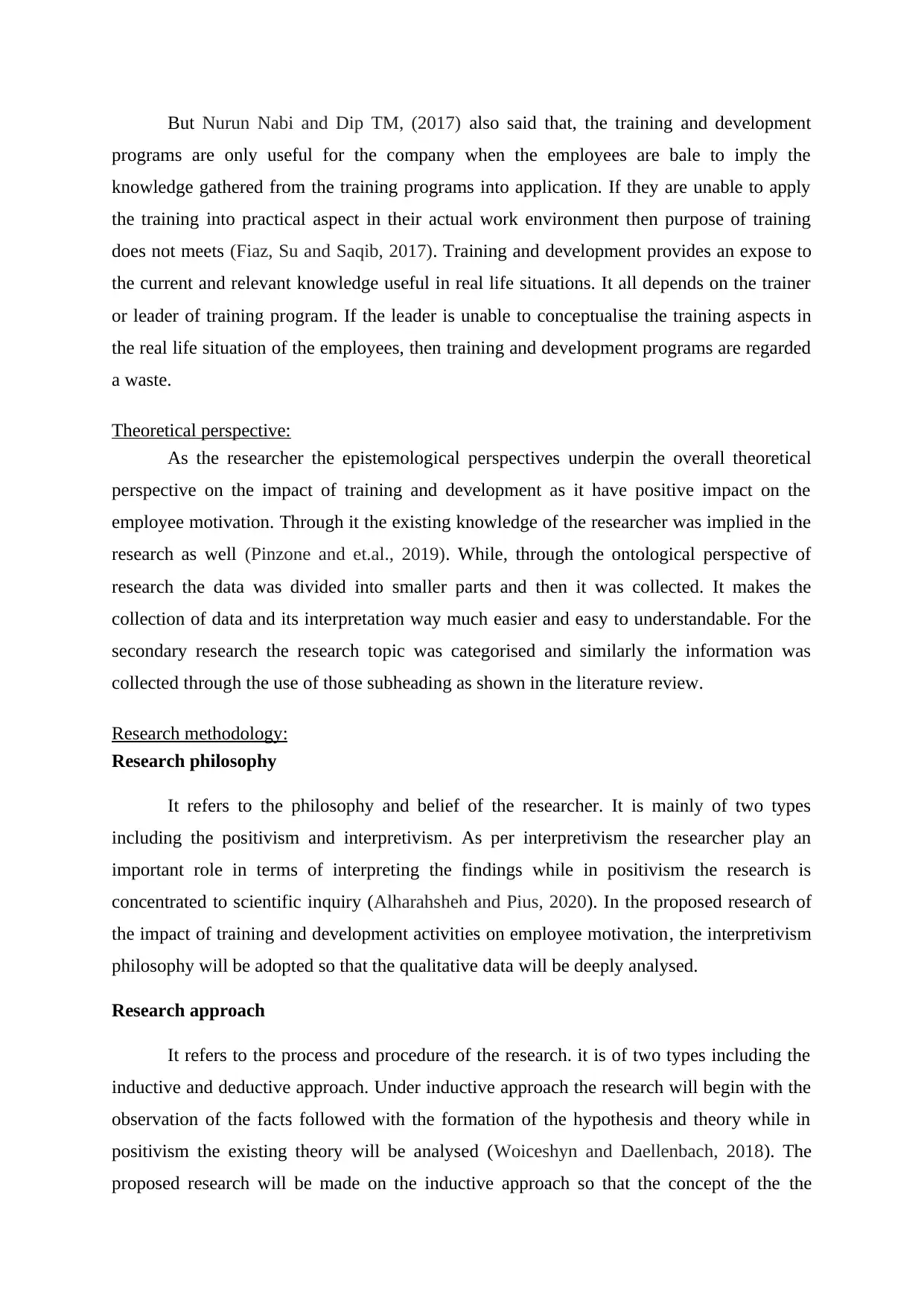
But Nurun Nabi and Dip TM, (2017) also said that, the training and development
programs are only useful for the company when the employees are bale to imply the
knowledge gathered from the training programs into application. If they are unable to apply
the training into practical aspect in their actual work environment then purpose of training
does not meets (Fiaz, Su and Saqib, 2017). Training and development provides an expose to
the current and relevant knowledge useful in real life situations. It all depends on the trainer
or leader of training program. If the leader is unable to conceptualise the training aspects in
the real life situation of the employees, then training and development programs are regarded
a waste.
Theoretical perspective:
As the researcher the epistemological perspectives underpin the overall theoretical
perspective on the impact of training and development as it have positive impact on the
employee motivation. Through it the existing knowledge of the researcher was implied in the
research as well (Pinzone and et.al., 2019). While, through the ontological perspective of
research the data was divided into smaller parts and then it was collected. It makes the
collection of data and its interpretation way much easier and easy to understandable. For the
secondary research the research topic was categorised and similarly the information was
collected through the use of those subheading as shown in the literature review.
Research methodology:
Research philosophy
It refers to the philosophy and belief of the researcher. It is mainly of two types
including the positivism and interpretivism. As per interpretivism the researcher play an
important role in terms of interpreting the findings while in positivism the research is
concentrated to scientific inquiry (Alharahsheh and Pius, 2020). In the proposed research of
the impact of training and development activities on employee motivation, the interpretivism
philosophy will be adopted so that the qualitative data will be deeply analysed.
Research approach
It refers to the process and procedure of the research. it is of two types including the
inductive and deductive approach. Under inductive approach the research will begin with the
observation of the facts followed with the formation of the hypothesis and theory while in
positivism the existing theory will be analysed (Woiceshyn and Daellenbach, 2018). The
proposed research will be made on the inductive approach so that the concept of the the
programs are only useful for the company when the employees are bale to imply the
knowledge gathered from the training programs into application. If they are unable to apply
the training into practical aspect in their actual work environment then purpose of training
does not meets (Fiaz, Su and Saqib, 2017). Training and development provides an expose to
the current and relevant knowledge useful in real life situations. It all depends on the trainer
or leader of training program. If the leader is unable to conceptualise the training aspects in
the real life situation of the employees, then training and development programs are regarded
a waste.
Theoretical perspective:
As the researcher the epistemological perspectives underpin the overall theoretical
perspective on the impact of training and development as it have positive impact on the
employee motivation. Through it the existing knowledge of the researcher was implied in the
research as well (Pinzone and et.al., 2019). While, through the ontological perspective of
research the data was divided into smaller parts and then it was collected. It makes the
collection of data and its interpretation way much easier and easy to understandable. For the
secondary research the research topic was categorised and similarly the information was
collected through the use of those subheading as shown in the literature review.
Research methodology:
Research philosophy
It refers to the philosophy and belief of the researcher. It is mainly of two types
including the positivism and interpretivism. As per interpretivism the researcher play an
important role in terms of interpreting the findings while in positivism the research is
concentrated to scientific inquiry (Alharahsheh and Pius, 2020). In the proposed research of
the impact of training and development activities on employee motivation, the interpretivism
philosophy will be adopted so that the qualitative data will be deeply analysed.
Research approach
It refers to the process and procedure of the research. it is of two types including the
inductive and deductive approach. Under inductive approach the research will begin with the
observation of the facts followed with the formation of the hypothesis and theory while in
positivism the existing theory will be analysed (Woiceshyn and Daellenbach, 2018). The
proposed research will be made on the inductive approach so that the concept of the the
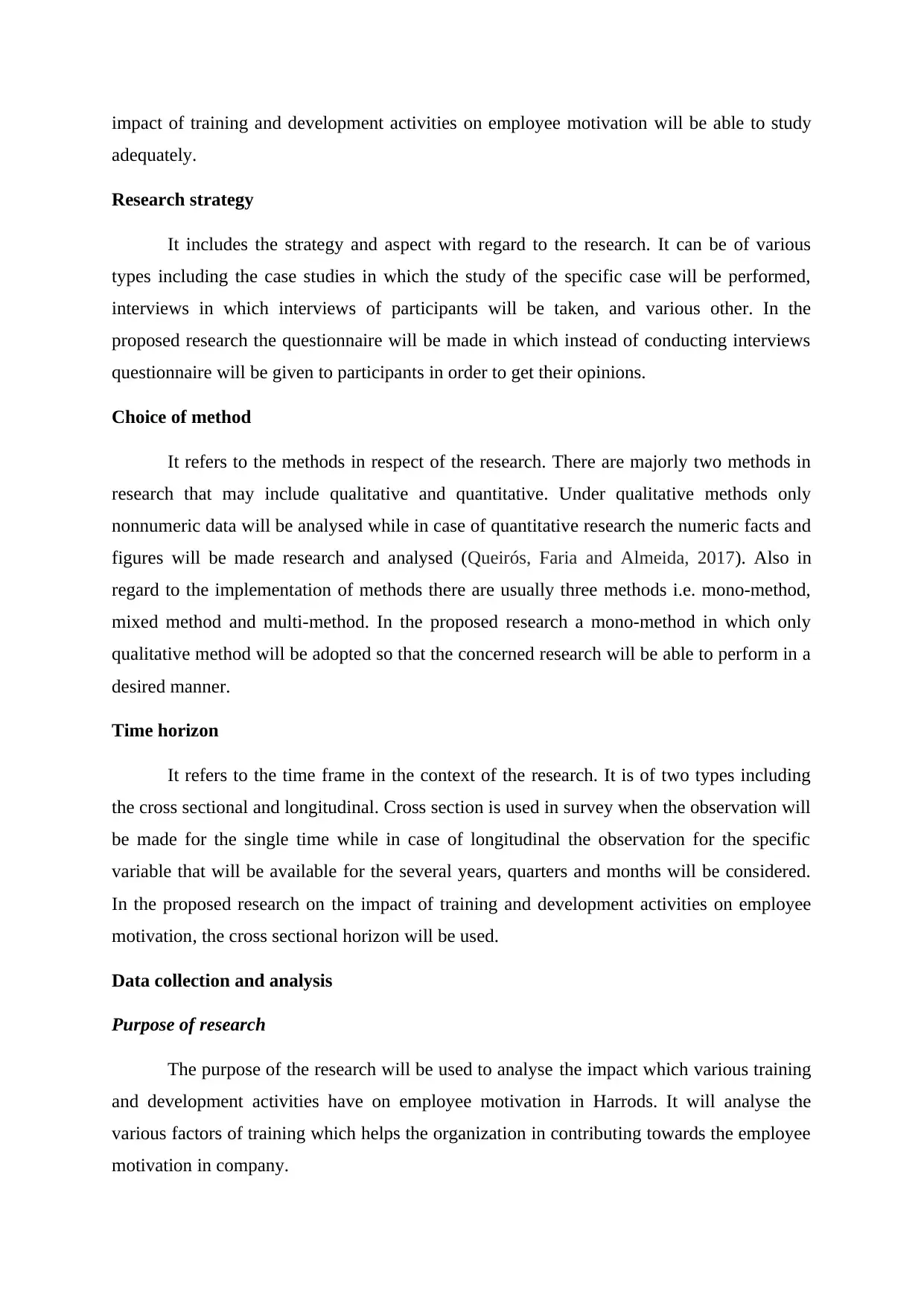
impact of training and development activities on employee motivation will be able to study
adequately.
Research strategy
It includes the strategy and aspect with regard to the research. It can be of various
types including the case studies in which the study of the specific case will be performed,
interviews in which interviews of participants will be taken, and various other. In the
proposed research the questionnaire will be made in which instead of conducting interviews
questionnaire will be given to participants in order to get their opinions.
Choice of method
It refers to the methods in respect of the research. There are majorly two methods in
research that may include qualitative and quantitative. Under qualitative methods only
nonnumeric data will be analysed while in case of quantitative research the numeric facts and
figures will be made research and analysed (Queirós, Faria and Almeida, 2017). Also in
regard to the implementation of methods there are usually three methods i.e. mono-method,
mixed method and multi-method. In the proposed research a mono-method in which only
qualitative method will be adopted so that the concerned research will be able to perform in a
desired manner.
Time horizon
It refers to the time frame in the context of the research. It is of two types including
the cross sectional and longitudinal. Cross section is used in survey when the observation will
be made for the single time while in case of longitudinal the observation for the specific
variable that will be available for the several years, quarters and months will be considered.
In the proposed research on the impact of training and development activities on employee
motivation, the cross sectional horizon will be used.
Data collection and analysis
Purpose of research
The purpose of the research will be used to analyse the impact which various training
and development activities have on employee motivation in Harrods. It will analyse the
various factors of training which helps the organization in contributing towards the employee
motivation in company.
adequately.
Research strategy
It includes the strategy and aspect with regard to the research. It can be of various
types including the case studies in which the study of the specific case will be performed,
interviews in which interviews of participants will be taken, and various other. In the
proposed research the questionnaire will be made in which instead of conducting interviews
questionnaire will be given to participants in order to get their opinions.
Choice of method
It refers to the methods in respect of the research. There are majorly two methods in
research that may include qualitative and quantitative. Under qualitative methods only
nonnumeric data will be analysed while in case of quantitative research the numeric facts and
figures will be made research and analysed (Queirós, Faria and Almeida, 2017). Also in
regard to the implementation of methods there are usually three methods i.e. mono-method,
mixed method and multi-method. In the proposed research a mono-method in which only
qualitative method will be adopted so that the concerned research will be able to perform in a
desired manner.
Time horizon
It refers to the time frame in the context of the research. It is of two types including
the cross sectional and longitudinal. Cross section is used in survey when the observation will
be made for the single time while in case of longitudinal the observation for the specific
variable that will be available for the several years, quarters and months will be considered.
In the proposed research on the impact of training and development activities on employee
motivation, the cross sectional horizon will be used.
Data collection and analysis
Purpose of research
The purpose of the research will be used to analyse the impact which various training
and development activities have on employee motivation in Harrods. It will analyse the
various factors of training which helps the organization in contributing towards the employee
motivation in company.
⊘ This is a preview!⊘
Do you want full access?
Subscribe today to unlock all pages.

Trusted by 1+ million students worldwide
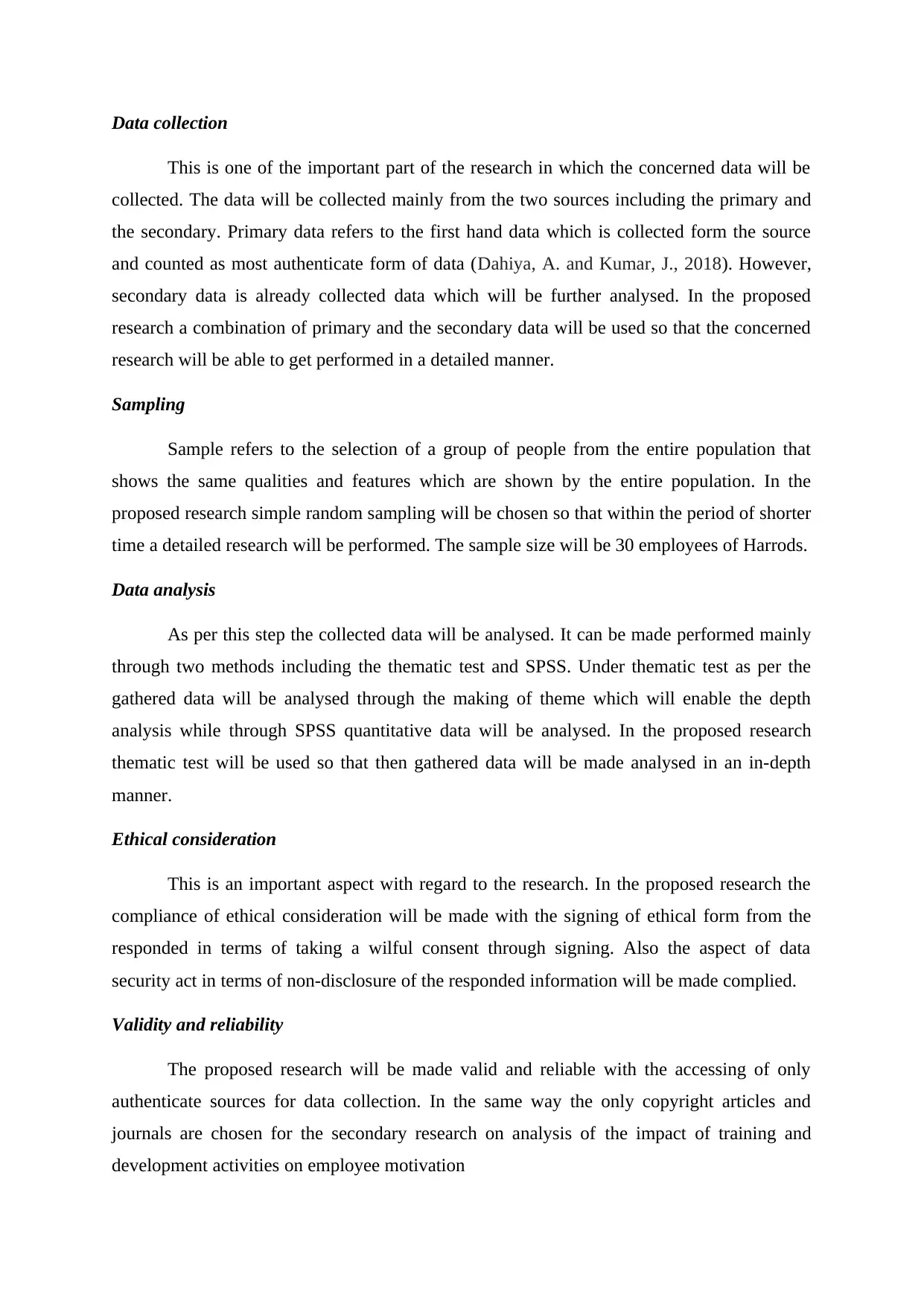
Data collection
This is one of the important part of the research in which the concerned data will be
collected. The data will be collected mainly from the two sources including the primary and
the secondary. Primary data refers to the first hand data which is collected form the source
and counted as most authenticate form of data (Dahiya, A. and Kumar, J., 2018). However,
secondary data is already collected data which will be further analysed. In the proposed
research a combination of primary and the secondary data will be used so that the concerned
research will be able to get performed in a detailed manner.
Sampling
Sample refers to the selection of a group of people from the entire population that
shows the same qualities and features which are shown by the entire population. In the
proposed research simple random sampling will be chosen so that within the period of shorter
time a detailed research will be performed. The sample size will be 30 employees of Harrods.
Data analysis
As per this step the collected data will be analysed. It can be made performed mainly
through two methods including the thematic test and SPSS. Under thematic test as per the
gathered data will be analysed through the making of theme which will enable the depth
analysis while through SPSS quantitative data will be analysed. In the proposed research
thematic test will be used so that then gathered data will be made analysed in an in-depth
manner.
Ethical consideration
This is an important aspect with regard to the research. In the proposed research the
compliance of ethical consideration will be made with the signing of ethical form from the
responded in terms of taking a wilful consent through signing. Also the aspect of data
security act in terms of non-disclosure of the responded information will be made complied.
Validity and reliability
The proposed research will be made valid and reliable with the accessing of only
authenticate sources for data collection. In the same way the only copyright articles and
journals are chosen for the secondary research on analysis of the impact of training and
development activities on employee motivation
This is one of the important part of the research in which the concerned data will be
collected. The data will be collected mainly from the two sources including the primary and
the secondary. Primary data refers to the first hand data which is collected form the source
and counted as most authenticate form of data (Dahiya, A. and Kumar, J., 2018). However,
secondary data is already collected data which will be further analysed. In the proposed
research a combination of primary and the secondary data will be used so that the concerned
research will be able to get performed in a detailed manner.
Sampling
Sample refers to the selection of a group of people from the entire population that
shows the same qualities and features which are shown by the entire population. In the
proposed research simple random sampling will be chosen so that within the period of shorter
time a detailed research will be performed. The sample size will be 30 employees of Harrods.
Data analysis
As per this step the collected data will be analysed. It can be made performed mainly
through two methods including the thematic test and SPSS. Under thematic test as per the
gathered data will be analysed through the making of theme which will enable the depth
analysis while through SPSS quantitative data will be analysed. In the proposed research
thematic test will be used so that then gathered data will be made analysed in an in-depth
manner.
Ethical consideration
This is an important aspect with regard to the research. In the proposed research the
compliance of ethical consideration will be made with the signing of ethical form from the
responded in terms of taking a wilful consent through signing. Also the aspect of data
security act in terms of non-disclosure of the responded information will be made complied.
Validity and reliability
The proposed research will be made valid and reliable with the accessing of only
authenticate sources for data collection. In the same way the only copyright articles and
journals are chosen for the secondary research on analysis of the impact of training and
development activities on employee motivation
Paraphrase This Document
Need a fresh take? Get an instant paraphrase of this document with our AI Paraphraser
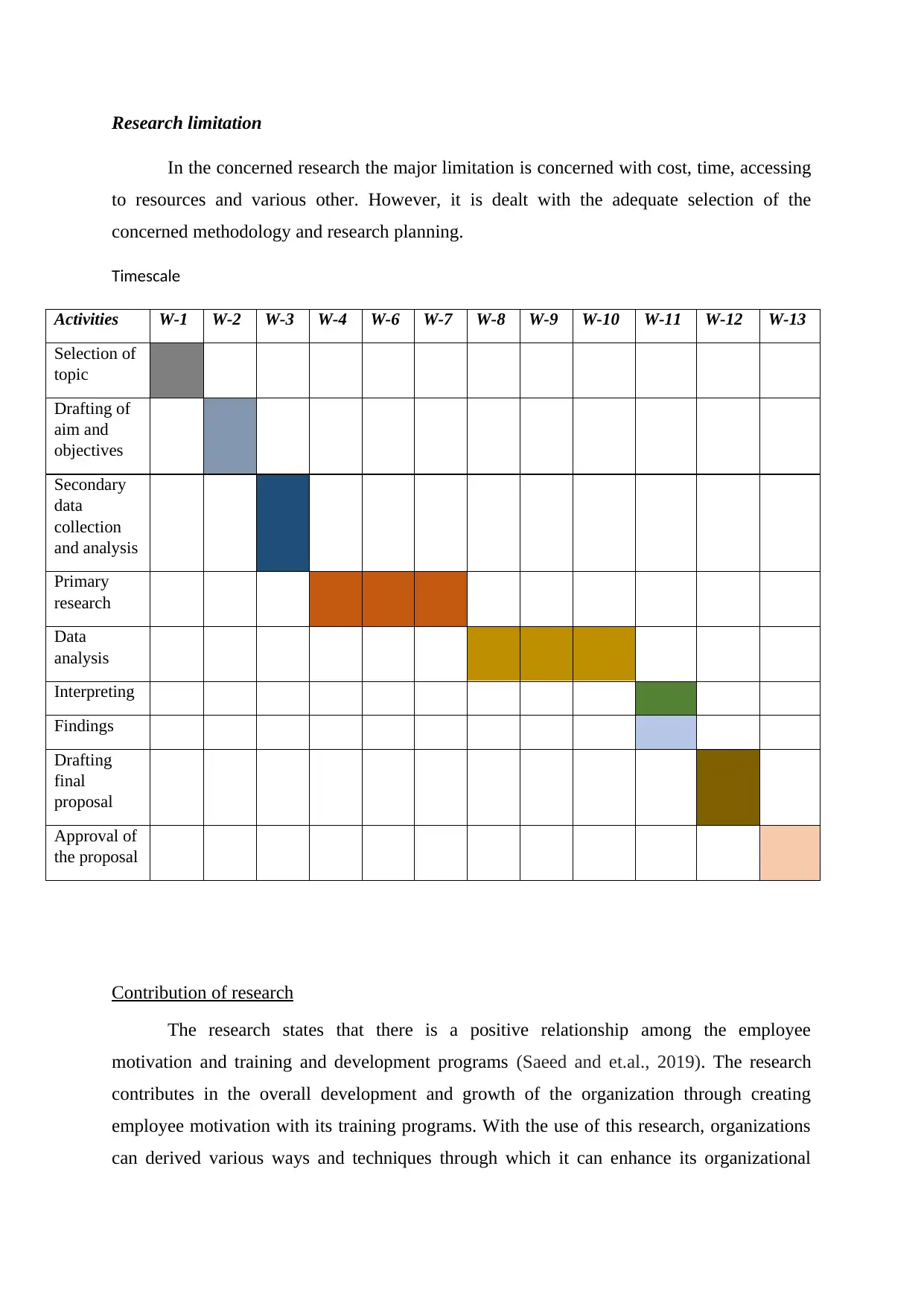
Research limitation
In the concerned research the major limitation is concerned with cost, time, accessing
to resources and various other. However, it is dealt with the adequate selection of the
concerned methodology and research planning.
Timescale
Activities W-1 W-2 W-3 W-4 W-6 W-7 W-8 W-9 W-10 W-11 W-12 W-13
Selection of
topic
Drafting of
aim and
objectives
Secondary
data
collection
and analysis
Primary
research
Data
analysis
Interpreting
Findings
Drafting
final
proposal
Approval of
the proposal
Contribution of research
The research states that there is a positive relationship among the employee
motivation and training and development programs (Saeed and et.al., 2019). The research
contributes in the overall development and growth of the organization through creating
employee motivation with its training programs. With the use of this research, organizations
can derived various ways and techniques through which it can enhance its organizational
In the concerned research the major limitation is concerned with cost, time, accessing
to resources and various other. However, it is dealt with the adequate selection of the
concerned methodology and research planning.
Timescale
Activities W-1 W-2 W-3 W-4 W-6 W-7 W-8 W-9 W-10 W-11 W-12 W-13
Selection of
topic
Drafting of
aim and
objectives
Secondary
data
collection
and analysis
Primary
research
Data
analysis
Interpreting
Findings
Drafting
final
proposal
Approval of
the proposal
Contribution of research
The research states that there is a positive relationship among the employee
motivation and training and development programs (Saeed and et.al., 2019). The research
contributes in the overall development and growth of the organization through creating
employee motivation with its training programs. With the use of this research, organizations
can derived various ways and techniques through which it can enhance its organizational
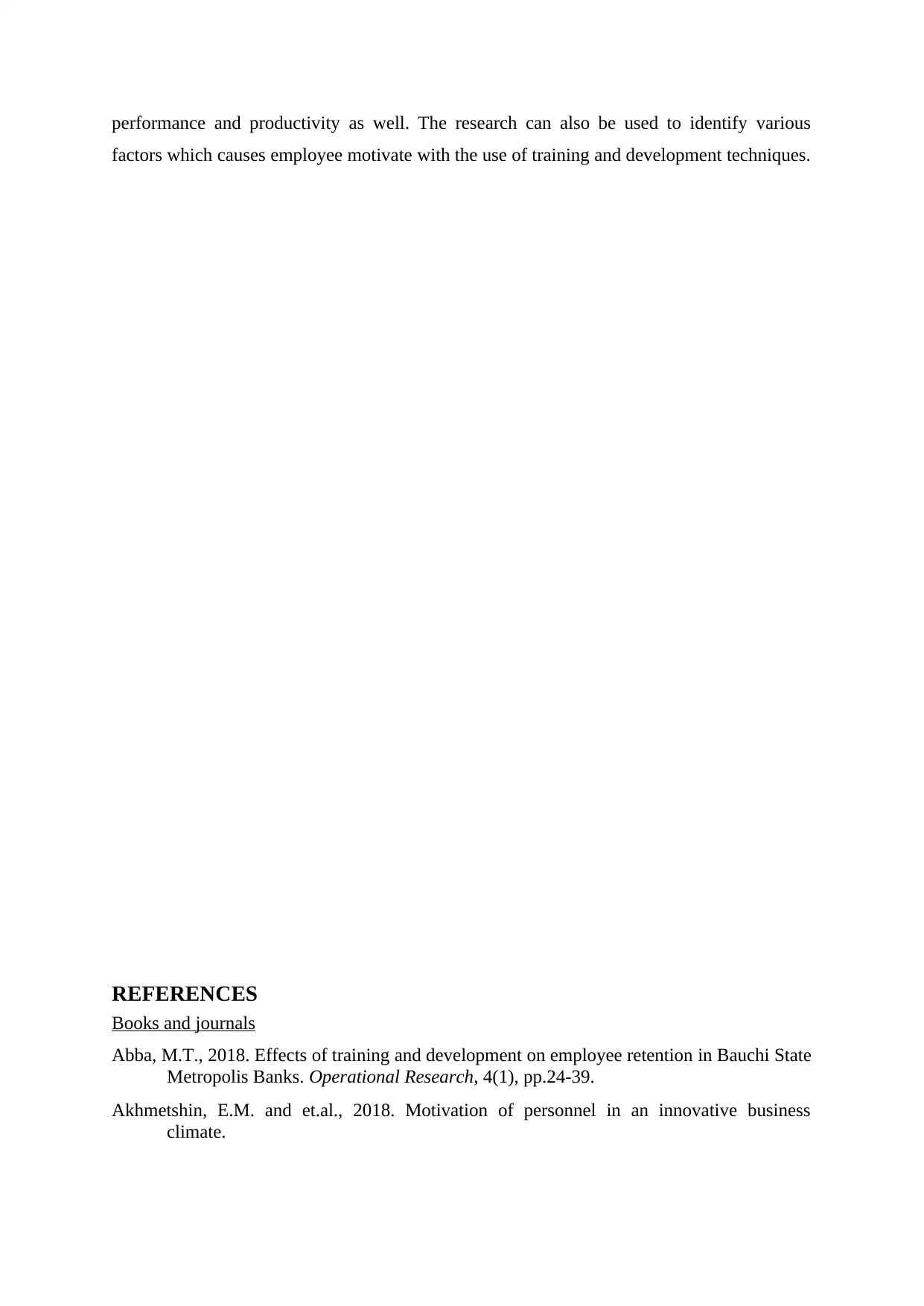
performance and productivity as well. The research can also be used to identify various
factors which causes employee motivate with the use of training and development techniques.
REFERENCES
Books and journals
Abba, M.T., 2018. Effects of training and development on employee retention in Bauchi State
Metropolis Banks. Operational Research, 4(1), pp.24-39.
Akhmetshin, E.M. and et.al., 2018. Motivation of personnel in an innovative business
climate.
factors which causes employee motivate with the use of training and development techniques.
REFERENCES
Books and journals
Abba, M.T., 2018. Effects of training and development on employee retention in Bauchi State
Metropolis Banks. Operational Research, 4(1), pp.24-39.
Akhmetshin, E.M. and et.al., 2018. Motivation of personnel in an innovative business
climate.
⊘ This is a preview!⊘
Do you want full access?
Subscribe today to unlock all pages.

Trusted by 1+ million students worldwide
1 out of 14
Related Documents
Your All-in-One AI-Powered Toolkit for Academic Success.
+13062052269
info@desklib.com
Available 24*7 on WhatsApp / Email
![[object Object]](/_next/static/media/star-bottom.7253800d.svg)
Unlock your academic potential
Copyright © 2020–2025 A2Z Services. All Rights Reserved. Developed and managed by ZUCOL.



